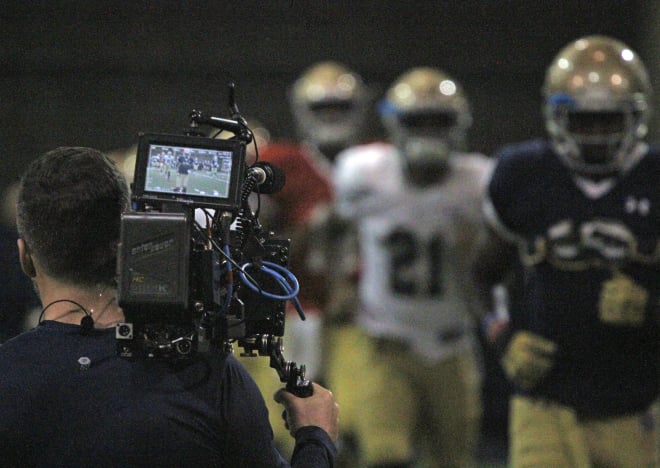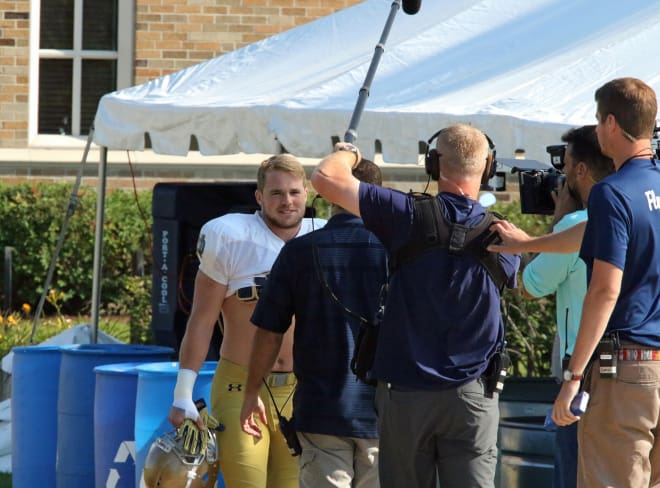Notre Dame’s Showtime Experience

A popular expression about curiosity is “I would have loved to have been a fly on the wall” when it comes to the desire of knowing more about a topic.
Since this August, and right through the Jan. 1 Fiesta Bowl, the Showtime cable network became that proverbial fly with the Notre Dame football team. The series “A Season with Notre Dame Football” debuted on Tuesday, Sept. 8, and became a weekly half-hour staple at 10 p.m. ET, adding in the “adult language, adult content” warnings to its telecast. The final installment ran on Jan. 5.
The purpose of the show was to give viewers an all-access, behind-the-scenes look at the Fighting Irish football team throughout the 2015 season, from the practices, staff meetings, the sidelines during game day, or even a day in the life of some players, including the preparation for mid-term exams in October.
At times, that “fly” could be a distraction, but overall the reward was deemed far more gratifying than what some might have perceived as an initial risk.
The all-access concept was not really ground breaking. One of the most famous ones included author John Feinstein’s best-selling Season On The Brink book that chronicled Indiana University’s 1985-86 basketball season. Surprisingly, volatile Hoosiers head coach Bob Knight opened the doors to Feinstein for an all-access full season with Indiana basketball — a move Knight regretted later.
However, that was merely the written word. By 2001, the cable network HBO introduced “Hard Knocks,” a reality television series visually chronicling the lives of an NFL team in training camp as it prepared for an arduous 16-game regular season.
Around 2010, current Showtime executive producer Scott Stone began contemplating having a similar series on a college football team, except this would focus on the entire season.
From the outset, Stone’s top prize for such a series was the University of Notre Dame.
The Plan
According to Stone, the blueprint would be different from “Hard Knocks” because whereas the HBO series followed NFL training camp, in college the emphasis would be on the actual football season and the lives of student-athletes. Recruiting the right school for such a show began in earnest early last summer.
“The thought was that if we could do it in college as opposed to the pros, the stakes are even higher than that because these guys are in school, away from home and they’re becoming adults,” Stone said. “It would be a story to allow character development.”
Next was finding the right school to tell the story and one that understood and appreciated the value of doing such a show.
“We approached every top program you could think of, with one or two exceptions,” Stone said.
There was some trepidation among many schools about being “the first” or the “guinea pig” to do such a documentary. In some cases there was initial excitement before backing off, and in other situations a school’s own conference network contract frowned upon it.
“We always said there are probably a dozen programs we would like to do this with, and unless we can get one of them, it wasn’t worth doing the show,” Stone said. “Notre Dame was right at the top of the list.”
One of the main reasons why was because Stone didn’t want the project to be strictly about football. He wanted to humanize the student-athlete and the daily lives they face, including preparing for other tasks. That was highlighted during USC week, which also coincided with midterms. One of Stone’s favorite lines in the series came from freshman defensive tackle Jerry Tillery when he said, “Saturday we play USC, but tonight I have to play chemistry.”
When head coach Brian Kelly was approached about the opportunity, he jumped at it, especially because of the knowledge that he had a bona fide top-10 team that could contend for a College Football Playoff berth.
“There were several schools that did not have the confidence that Coach Kelly had,” Stone said. “They said, ‘Let me see the first season, and then we’ll come back to you. We’re definitely in once we see what the show looks like.’
“Oftentimes, though, the best is the first shot. There were three or four schools willing to take the shot, but Notre Dame had all the right ingredients for us: great program, great academics, great coach, great student-athletes and a big national audience.”
Transparency And Understanding
The rise in social media, from Facebook to Twitter to Instagram, facilitated the receptiveness to the new project by Showtime.
“The universities now have a better understanding of what social media is all about,” Stone said. “Before there was social media, there was, ‘Why would they want to let people in on the inside of a football team?’ There was so much a sense of secrecy.
“With social media, people began to realize you have to open up your doors because everyone’s doing it anyway. There are no secrets.
“Everybody has a camera on their phones, so any moments that you really want to get there are going to get out there regardless … it’s just a matter of course. Most of the ‘millennials’ that are in college right now are leading their lives in public.
“When coaches and universities caught up with the reality that there is no such thing as keeping things closed up. … There is actually a great benefit of doing that, in being transparent and letting people know all about your program. They can see how hard everyone is working, the difficulties they go through, the way their characters deal with the stress that goes not only with becoming an elite football team but also an elite academic program.”
Kelly’s enthusiasm about the project made it easier for the administrators at the highest level of the school to sign off on it.
Like any partnership, a give and take was required. Showtime made it clear that this would not be strictly an “infomercial” for the school but that real stories, sometimes not always pleasant, needed to be told, and sometimes the “F bombs” on the sidelines or other aspects would be caught on camera for posterity. Showtime had the call on the final cut of every show and did not want to have anything contrived.
“They were committing that we would tell the story in a way that is satisfactory to both the television viewing audience and also Coach Kelly and the university,” Stone summarized. “Coach Kelly understands your story is only as good as your struggles. That’s what comes with the territory. You don’t just get a year where everything goes right. That was always part of the story, and he’ll tell you the real story is not about how you deal with your successes; it’s how you deal with your failures.
“One of the things we promised Coach Kelly is that we would show him as a fully rounded, fully developed character. If we show you being very fiery on the sideline, we’re also going to show you being very parental. We wouldn’t show just one dimension of Coach Kelly.”
Among the favorite scenes for Stone was Kelly’s meeting with junior quarterback Malik Zaire’s mother in the hallway after a devastated Zaire and his family learned he would be out the remainder of the season following his fractured ankle in game two at Virginia Sept. 12.
“That’s the moment he understood exactly what she wanted to hear, and it came from his heart: ‘We’re going to take care of him, he’ll be with us … just know that we will take care of him,’” Stone said. “As a parent, when you send your kid away to college, you dream of somebody at the school saying that.”

Memories For A Lifetime
Stone said the most gratifying aspect of “A Season With Notre Dame” was the feedback from the Fighting Irish players.
“When student-athletes tell us we got it right, that’s the ultimate compliment as a storyteller,” Stone said.
For a weekly half-hour show, not everyone could be featured, nor did everyone want to be on camera, but people such as Tillery and senior Sheldon Day, both defensive linemen, were naturals in front of the lens. Fifth-year senior and team captain Joe Schmidt was a compelling story, and so was sophomore quarterback DeShone Kizer.
“Showtime was a special experience that’s going to happen only every once in a while,” Kizer said. “As a player and person who was a part of that, it was a privilege to have them along with us. There’s going to be footage that I’m going to use for the rest of my life to show my family.”
Kizer also developed some media savvy along the way that has made him a quick study and leader.
“They did a good job with editing out the stuff that I didn’t really want people to see,” he said. “I figured out that if I say the word ‘Showtime’ while I’m doing something I don’t want on there, they can’t put it on there.
“Anytime I was in a position where I didn’t want anyone to see it, I would just start yelling ‘Showtime!’ I knew they couldn’t use it.”
No Regrets
Notre Dame football media relations director Michael Bertsch admitted he had initial apprehensions about the show because of the spontaneity aspect.
“One of the early things I struggled with was the desire of the show to be real and on the fly. Any of the interviews you saw on the show were in the locker room, or right after practice, right on the field … at times I like to work with the guys and talk to them about some stuff that might get asked and make them as comfortable as possible,” Bertsch said. “When you get a kid immediately after that, it’s great for Showtime because they get that raw emotion interview. But it was more difficult for me.”
Bertsch cringed at some footage such as senior nose guard Jarron Jones’ knee injury in practice, and admitted huge disappointment about the scene that showed senior left tackle Ronnie Stanley addressing teammates on why he can’t accept a captaincy. Overall, though, Bertsch said there were no major confrontations with the camera crew and the Showtime people were “awesome.”
Kelly said the documentary was a positive, but said there would be no sequels.
“It was my decision to bring the cameras in, because I felt our program was at a point where this is who we are,” Kelly said. “We’re not changing. What you see is what you get.
“It was a calculated decision to allow those cameras to come in and take a look at who we were without being scripted. And whatever happened, happened.
“There were some good things that happened, and there were some not great things that happened. But I wanted them to be able to portray and show who we were, and from what I hear it’s been a positive experience for those who have watched the show. And I know from the recruits, they liked it because they got to see a lot more of the program they wouldn’t normally see.”
“Notre Dame provides so much, but what really turned me was the show,” said prep safety Devin Studstill, a a Florida native and one of five recruits already enrolled at Notre Dame for the spring semester. “That gave me the insight of the everyday life of players. That was great and very positive for me.”
“Knowing now what I know about how it’s been a positive thing, I would do it over again from that perspective,” Kelly said. “But I wouldn’t bring them back in for a second year.”
Stone and Showtime won’t have any problems with takers in the future. Schools have already reached out to Showtime to volunteer to do such a documentary in the future after watching the shows on the Fighting Irish.
For Notre Dame, it got it right on “the first take.”